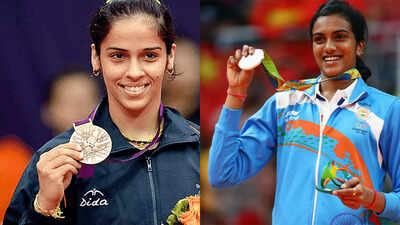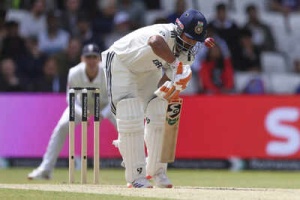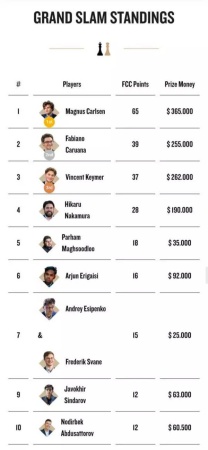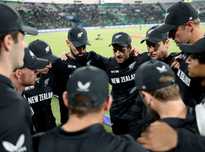After a period of unprecedented success led by Saina Nehwal and PV Sindhu, Indian badminton is currently experiencing a significant decline. The sport, which had carved out a prominent space in India's sporting landscape, is now struggling to maintain its previous momentum.

Saina Nehwal and PV Sindhu, once the faces of Indian badminton.
Recent results have been disappointing, raising concerns about the future of Indian badminton. The current situation isn't merely a temporary setback; the absence of promising successors to Saina Nehwal and PV Sindhu paints a concerning picture. Nehwal, a trailblazer at 35, and Sindhu, a 29-year-old two-time Olympic medalist, are both struggling to overcome initial challenges in tournaments.
The contrast is stark: from securing three women's singles medals in consecutive Olympics, achieving a historic Thomas Cup victory in 2022, and winning the first Asian Games men's doubles gold in 2023, Indian badminton now lacks representation in the All England semifinals in 2025.
Except for Satwiksairaj Rankireddy and Chirag Shetty, and to some extent Lakshya Sen, the majority of Indian players are underperforming. The era when Saina Nehwal, PV Sindhu, Kidambi Srikanth, Sai Praneeth, HS Prannoy, and Satwik-Chirag were considered tournament favorites seems like a distant memory.
A worrying trend has emerged since HS Prannoy's Malaysia Open Super-500 title in January 2023: Indian players have struggled to secure singles titles. Only the doubles duo of Satwik-Chirag have managed to clinch a few victories. India's performance at the Sudirman Cup earlier this year was particularly poor, with the team exiting in the group stage after losses to Denmark and Indonesia.
The past decade was a period of great promise. Following Saina Nehwal's Olympic bronze at the London Games, PV Sindhu emerged with a bronze at the World Championships in 2013. Alongside Saina and Sindhu, players like Parupalli Kashyap, Kidambi Srikanth, Prannoy, and B Sai Praneeth gained prominence in the men's division. Srikanth even achieved the World No. 1 ranking and won four Super Series titles in 2017.
In 2019, Sindhu became a world champion, and Sai Praneeth secured a bronze at the World Championships. More recently, Srikanth showed glimpses of his former brilliance by reaching the final of the Malaysia Masters. However, his low ranking prevented him from entering subsequent tournaments.
While Satwik-Chirag have established India's dominance in men's doubles, they have also faced fitness challenges and have yet to reach a final this year. The responsibility of leading the men's singles challenge now falls on Lakshya Sen. Despite his potential, including reaching the All England final and winning a bronze at the Worlds, Sen has only won two Super-500 titles and is still seeking a Super-750 or Super-1000 title. Beyond Lakshya, there is a lack of players at the level of Srikanth or Prannoy. The women's scene is even more concerning, with no clear contender to lead the Indian challenge.
One factor contributing to the decline is the lack of a robust system to consistently produce players, unlike the established feeder systems in China or Malaysia. Despite Saina and Sindhu inspiring many young people to take up badminton, there is a shortage of trained coaches to nurture them. Furthermore, existing coaches have not been adequately trained to meet the increasing demand.
A more structured approach is needed, including identifying and grooming a core group of emerging players, dividing them into elite and developing groups to foster competition. Talented players like Malvika Bansod, Aakarshi Kashyap, and Tanvi Patri could benefit from focused training under one roof.
The Badminton Association of India (BAI) acknowledges the need for improvement. Secretary Sanjay Mishra stated that while injuries to key players have contributed to the setback, the transition of the next generation requires time. BAI is focused on enhancing coaching, injury management, and talent development.
Mishra expressed optimism about the future, noting that several junior players are ranked in the top 10 and that domestic competition reflects the rising caliber of emerging talents.
At its recent annual general meeting, BAI unveiled a plan to drive the growth of badminton. A source suggests categorizing coaches into three levels: those who identify and groom nascent talent, those who guide players through their formative years, and highly trained coaches who can develop international talents.
While BAI's efforts are commendable, a comprehensive overhaul is necessary to revitalize Indian badminton. This includes implementing a clear three- to five-year plan and ensuring that the association and coaches collaborate on tournament schedules for top players. A system similar to the one implemented by Pullela Gopichand should be replicated across the country to cultivate more champions. Without a proper system in place, Indian badminton risks sliding into mediocrity.
Newer articles
Older articles
 Hetmyer's Heroics: Orcas Stun MI New York with Last-Ball Six in Record-Breaking MLC Chase
Hetmyer's Heroics: Orcas Stun MI New York with Last-Ball Six in Record-Breaking MLC Chase
 Android Users Face Critical Security Risks: Update Your Devices Now, Warns Government Agency
Android Users Face Critical Security Risks: Update Your Devices Now, Warns Government Agency
 Greg Chappell Hails Rishabh Pant's "Revolutionary" Batting, Likens Him to Gilchrist
Greg Chappell Hails Rishabh Pant's "Revolutionary" Batting, Likens Him to Gilchrist
 Dog-Sized Dinosaur Fossil Unearths New Insights into Prehistoric Life Alongside Giants
Dog-Sized Dinosaur Fossil Unearths New Insights into Prehistoric Life Alongside Giants
 West Indies Captain Chase Slams Umpiring After Test Loss, Demands Accountability
West Indies Captain Chase Slams Umpiring After Test Loss, Demands Accountability
 IRCTC's AI Chatbot, AskDisha 2.0, Streamlines Train Ticket Booking, Refunds & Information
IRCTC's AI Chatbot, AskDisha 2.0, Streamlines Train Ticket Booking, Refunds & Information
 Freestyle Chess India Event Scrapped Due to Sponsorship Issues; Carlsen Absence Confirmed
Freestyle Chess India Event Scrapped Due to Sponsorship Issues; Carlsen Absence Confirmed
 Moto G54 Gets Significant Price Drop in India: Check Out the New Affordable Price Tag
Moto G54 Gets Significant Price Drop in India: Check Out the New Affordable Price Tag
 New Zealand Cricket Announces Packed 2025-26 Home Schedule Featuring Australia, England, West Indies & South Africa
New Zealand Cricket Announces Packed 2025-26 Home Schedule Featuring Australia, England, West Indies & South Africa
 Converting JPG to PDF: A Comprehensive Guide for Preserving Image Quality and Ensuring Accessibility
Converting JPG to PDF: A Comprehensive Guide for Preserving Image Quality and Ensuring Accessibility